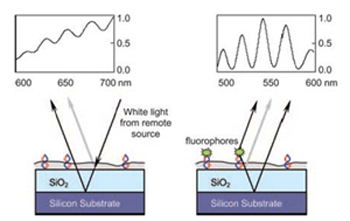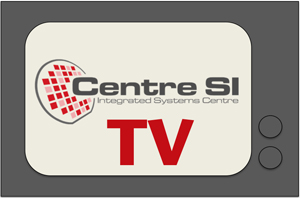Go to
July 4, 2008
Applications of Optical Resonance to Biological Imaging and Label-free Protein Microarrays
Selim Ünlü, Optical Characterization and Nanophotonics Laboratory, Department of Electrical and Computer Engineering, Boston University, Boston, MA
Abstract: Optical resonance is one of the key properties of light enabling important devices such as interference filters and lasers. We present application of optical resonance to biological sensing and imaging techniques. The importance of optical resonance has long been recognized and the interference due to multiple reflections had in fact been analyzed theoretically by George Airy nearly two centuries ago. Optical resonator has become a household name since Fabry and Perot and has been used for numerous sensing applications to improve sensitivity. Over the past 20 years we have been involved in the development of optoelectronic devices whose performance is enhanced by placing the active device structure inside a resonant microcavity [1].
 Schematic representation of the interferometric experimental configurations are shown along with examples of measured spectra for each technique. (Left) WL reflection spectroscopy is based on spectral variations of reflections from thin transparent films. Interference of light reflected from the top surface and a buried reference surface results in periodic oscillations. (Right) The SSFM technique maps the spectral oscillations emitted by a fluorophore located on a layered reflecting surface into a precise position determination. Analysis of the spectra oscillations (using a grating spectrometer) due to the self-interference from the direct and reflected emission yields the vertical position of that fluorophore with subnanometer accuracy.
Schematic representation of the interferometric experimental configurations are shown along with examples of measured spectra for each technique. (Left) WL reflection spectroscopy is based on spectral variations of reflections from thin transparent films. Interference of light reflected from the top surface and a buried reference surface results in periodic oscillations. (Right) The SSFM technique maps the spectral oscillations emitted by a fluorophore located on a layered reflecting surface into a precise position determination. Analysis of the spectra oscillations (using a grating spectrometer) due to the self-interference from the direct and reflected emission yields the vertical position of that fluorophore with subnanometer accuracy.
A novel application of resonance to fluorescence microscopy promises nanometer resolution in biological imaging. We have developed a technique - spectral self-interference fluorescent microscopy (SSFM) - that transforms the variation in emission intensity for different path lengths used in fluorescence interferometry to a variation in the intensity for different wavelengths in emission, encoding the high-resolution information in the emission spectrum. Using SSFM, we have estimated the shape of coiled single-stranded DNA, the average tilt of double-stranded DNA of different lengths, and the amount of hybridization [2]. The data provide important proofs of concept for the capabilities of novel optical surface analytical methods of the molecular disposition of DNA on surfaces. The determination of DNA conformations on surfaces and hybridization behavior provide information required to move DNA interfacial applications forward and thus impact emerging clinical and biotechnological fields. Recently, we have applied SSFM to study the conformational changes of polymers and DNA-protein complexes.
Direct monitoring of primary molecular binding interactions without the need for secondary reactants would markedly simplify and expand applications of high-throughput label-free detection methods. We developed a simple interferometric technique - Spectral Reflectance Imaging Biosensor (SRIB) - that monitors the optical phase difference resulting from accumulated biomolecular mass. [3]. As an example, 50 spots for each of four proteins consisting of bovine serum albumin, human serum albumin, rabbit IgG and protein G were dynamically monitored as they captured corresponding antibodies. Dynamic measurements were made at 26 pg/mm2 standard deviation per spot and with a detectable concentration of 19 ng/ml. We have further improved the sensitivity and demonstrated simultaneous detection of antigens and antibodies for solution using corresponding probes on the SRIB surface. The presented method is particularly relevant for protein microarray analysis since it is label-free, simple, sensitive, and easily scales to high throughput.
References
[1] M. S. Ünlü, and S. C. Strite, "Resonant Cavity Enhanced Photonic Devices," J. Appl. Phys., Vol. 78, No. 2, pp.607 - 639, (1995)
[2] L. Moiseev, M. S. Ünlü, A. K. Swan, B. B. Goldberg, and C. R. Cantor, "DNA Conformation on Surfaces Measured by Fluorescence Self-Interference," Proceedings of the National Academy of Science, Vol. 103, pp. 2623-2628, (2006)
[3] Ozkumur et al, "Label-free and dynamic detection of biomolecular interactions for high-throughput microarray applications," Proceedings of the National Academy of Science, in print 2008.
About the speaker: M. Selim Ünlü is a Professor of Electrical and Computer Engineering, Biomedical Engineering, and Physics at Boston University. He is also serving as the Associate Dean for Research and Graduate Programs as well as the Associate Director of Center for Nanoscience and Nanobiotechnology.
Prof. Ünlü received the B.S. degree in electrical engineering from Middle East Technical University, Ankara, Turkey, in 1986, and the M.S.E.E. and Ph.D. in electrical engineering from the University of Illinois, Urbana-Champaign, in 1988 and 1992, respectively. In 1992, he joined the Department of Electrical and Computer Engineering, Boston University, as an assistant professor. He worked as a visiting professor at University of Ulm, Germany in 2000, ETH Zürich, Switzerland in 2006, and Koc University, Istanbul, Turkey in 2007.
Dr. Ünlü's career interests are in the areas of nanophotonics and biophotonics. Currently, he is working on high-resolution solid immersion lens microscopy of semiconductor devices and circuits, as well as biosensor fabrication and development of biological imaging techniques, particularly in high-throughput, label-free microarrays. In 2008, he started Zoíray Technology Inc. for commercialization of label-free immunoassays, and serves as the Chief Technology Officer.
During 1994-1995, Dr. Ünlü served as the Chair of IEEE Laser and Electro-Optics Society, Boston Chapter, winning the LEOS Chapter-of-the-Year Award. He was awarded National Science Foundation Research Initiation Award in 1993, United Nations TOKTEN award in 1995 and 1996, and both the National Science Foundation CAREER and Office of Naval Research Young Investigator Awards in 1996. He has authored and co-authored over 250 technical articles and several book chapters and magazine articles; edited one book; and holds several patents. His professional service includes the former chair of the IEEE/LEOS technical subcommittee on photodetectors and imaging and currently, the chair of IEEE/LEOS Nanophotonics and an Associate Editor for IEEE Journal of Quantum Electronics. Dr. Ünlü has been selected as a LEOS Distinguished Lecturer for 2005-2007 and Australian Research Council Nanotechnology Network (ARCNN) Distinguished Lecturer for 2007. He has been elevated to IEEE Fellow rank in 2007 for his contributions to optoelectronic devices.
Secondary navigation
- January 29, 2018
- August 30, 2017
- Past seminars
- 2016 - 2017 Seminars
- 2015 - 2016 Seminars
- 2014 - 2015 Seminars
- 2013 - 2014 Seminars
- 2012 - 2013 Seminars
- 2011 - 2012 Seminars
- 2010 - 2011 Seminars
- 2009 - 2010 Seminars
- 2008 - 2009 Seminars
- 2007 - 2008 Seminars
- 2006 - 2007 Seminars
- August 31, 2007
- June 29, 2007
- June 20, 2007
- June 5, 2007
- May 30, 2007
- May 16, 2007
- May 15, 2007
- April 24, 2007
- March 27, 2007
- March 14, 2007
- February 9, 2007
- February 8, 2007
- January 12, 2007
- December 5, 2006
- November 14, 2006
- October 31, 2006
- October 27, 2006
- October 26, 2006
- October 20, 2006
- September 20, 2006
- September 20, 2006
- September 20, 2006
- September 19, 2006
- 2005 - 2006 Seminars
- August 23, 2006
- August 22, 2006
- June 26, 2006
- June 20, 2006
- June 16, 2006
- June 7, 2006
- June 6, 2006
- May 30, 2006
- May 17, 2006
- May 10, 2006
- April 27, 2006
- April 12, 2006
- March 31, 2006
- March 29, 2006
- March 22, 2006
- March 15, 2006
- February 27, 2006
- February 8, 2006
- January 25, 2006
- January 19, 2006
- January 18, 2006
- January 17, 2006
- January 11, 2006
- November 30, 2005
- November 23, 2005
- November 2, 2005
- October 26, 2005
- October 25, 2005
- October 5, 2005
- September 28, 2005
- 2005 Seminars

